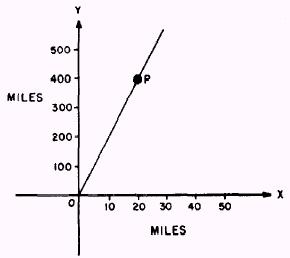|
PARAMETRIC EQUATIONS
If the variables x and y of the Cartesian coordinate
system are expressed in terms of a third variable, say t (or 9), then the
variable
t (or
 ) is
called a parameter.
The two equations x = x(t) and y = y(t) [or x = x(
) is
called a parameter.
The two equations x = x(t) and y = y(t) [or x = x(
 ) and y =
y(
) and y =
y(
 )] are
called parametric equations.
)] are
called parametric equations.
MOTION IN A STRAIGHT LINE
To illustrate the application of a parameter, we will
assume that an aircraft takes off from azoo
field, which we will call the origin. Figure 3-6 shows
the diagram we will use. The aircraft is flying on a compass heading of due
north. There is a wind blowing from the west at 20 miles per hour, and the
airspeed of the aircraft is 400 miles per hour. Let the direction of the
positive Y axis be due north and the positive X axis be due east, as shown in
figure 3-6. Use the scales as shown.

Figure 3-6.-Aircraft position.
One hour after takeoff the position of the aircraft,
represented by point P, is 400 miles north and 20 miles east of the origin. If
we use t as the parameter, then at any time, t, the aircraft's position (x,y) will be given by x
equals 20t and y equals 400t. The equations are
x = 20t
and
y = 400t
and are called parametric equations. Notice that time is
not plotted on the graph of figure 3-6. The parameter t is used only to plot
the position (x,y) of the aircraft.
We may eliminate the parameter t to obtain a direct
relationship between x and y as follows:
if

then

and we find the graph to be a straight line. When we
eliminated the parameter, the result was the rectangular coordinate equation of
the line.
|

